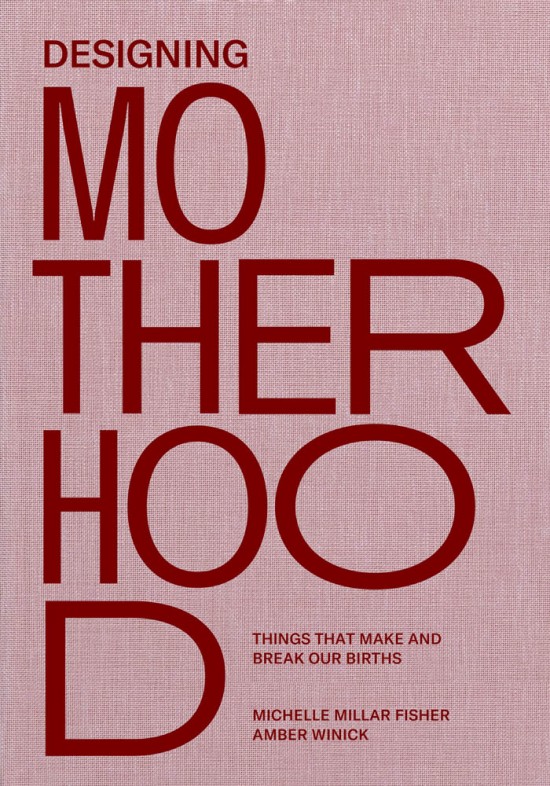Unfolding the histories and real-world uses of designs that have defined the arc of human reproduction, revealing the complicated fight for reproductive justice that hangs in the balance
While birth often brings great joy, making babies is a knotty enterprise. The designed objects that surround people when it comes to menstruation, birth control, conception, pregnancy, childbirth, and early motherhood vary as oddly, messily, and dramatically as the stereotypes suggest.
 With Designing Motherhood: Things that Make and Break Our Births, authors Michelle Millar Fisher and Amber Winick strive to illustrate the crucial roles design and material culture play throughout the arc of human reproduction. They explore more than eighty designs—iconic, conceptual, titillating, emotionally charged, or just plain strange—that have defined the relationships between people and babies during the past century.
With Designing Motherhood: Things that Make and Break Our Births, authors Michelle Millar Fisher and Amber Winick strive to illustrate the crucial roles design and material culture play throughout the arc of human reproduction. They explore more than eighty designs—iconic, conceptual, titillating, emotionally charged, or just plain strange—that have defined the relationships between people and babies during the past century.
Fisher, a curator and architecture and design historian, and Winick, a writer and design historian, unfold the compelling design histories and real-world uses of these objects. The authors investigate the baby carrier, from the Snugli to BabyBjörn, and the (re)discovery of the varied traditions of baby wearing; the tie-waist skirt, famously worn by a pregnant Lucille Ball on I Love Lucy, and essential for camouflaging and slowly normalizing a public pregnancy; the home pregnancy kit, and its threat to the authority of male gynecologists; and more.
“This book sprung from our shared curiosity about why the material culture that defines our reproductive lives was so hidden,” Fisher and Winick wrote in a piece for Publishers Weekly Soapbox. “Such objects, spaces, and ideas should be among the most well-considered design solutions; designers should aspire to work on them.” The objects and spaces in question range from contraceptives, breast pumps, and menstrual cups to labor and delivery wards, and at-home abortion kits. Each object, they argue, tells a story.
With 225 color illustrations and images in the book—including historical ads, found photos, and drawings—and accompanying public programs, design curricula, and even a museum exhibit co-curated by Fisher, Winick, and design historian Juliana Rowen Barton at the Mütter Museum at the College of Physicians of Philadelphia, it is safe to argue that the authors are giving these objects the attention they have long-deserved.
Designing Motherhood in the media:
- The authors were interviewed for the goop podcast to discuss how cultural gatekeepers impact the way we think of womanhood, who participates in conversations about different forms of mothering, and how we value (and devalue) the feminine.
What Does Mothering Look Like? - An excerpt from the book appeared in Slate, covering the history of maternity wear.
A beach ball in an unmade bed - The Washington Post’s vertical The Lily wrote about the ‘Designing Motherhood’ museum exhibit co-curated by Fisher, Winick, and design historian Juliana Rowen Barton at the Mütter Museum at the College of Physicians of Philadelphia.
Forceps, breast pumps, IUDs: This exhibit puts motherhood on display - Designing Motherhood was included in a The New York Times Book Review article covering the best new visual books.
What to Read: 5 Visual Books - A piece by The Boston Globe’s Nicole Graev Lipson discussed the practice in early photography, which Fisher and Winick cover in Designing Motherhood, of cropping caregivers out of photographs of children.
The ‘hidden mothers’ in old photographs - A visual excerpt from the book appeared in The Independent.
How do we design motherhood? - Smithsonian covered the book and museum exhibit, writing that the project “strives to challenge the stigma surrounding objects associated with pregnancy and reproductive health.”
Designing Motherhood: A new exhibition and book series offers an intimate view of reproductive history - An article in The Guardian covered Fisher and Winick’s work in both the book and the Mütter Museum exhibit.
Designing Motherhood: project puts objects shaped by maternity in focus - Brooklyn Rail reviewed the book, calling it “a more comprehensive and empowered approach to sexuality, procreation, and rearing.”
Designing Motherhood: Things that Make and Break Our Births - A New York Times Arts feature discussed the “provocative” book and exhibit, arguing that Designing Motherhood “makes the case that there is a whole world of objects pertaining to women, mothers and pregnant people that have been overlooked from the perspective of form and function, and unstudied in terms of how their designs came to be.”
Menstrual Cups in Museums? It’s Time. - A starred review in Booklistsays, “Designing Motherhood is not just a history but a call to action, an invitation to reflect on how objects, practices, and policies might be redesigned to better serve the diverse experiences of motherhood.”
Designing Motherhood: Things that Make and Break Our Births - The authors co-wrote a piece about the book for Publishers WeeklySoapbox, calling the publishing process for Designing Motherhood “the longest gestation of them all.”
How Two Authors Brought a Book on Birthing Into the World - “I believe [Designing Motherhood] is a work of major significance to design studies but also to feminism, gender studies, and cultural history. It certainly doesn’t take an expected view of what constitutes ‘design.’”
—Ellen Lupton, Senior Curator of Contemporary Design, Cooper Hewitt, Smithsonian Design Museum


